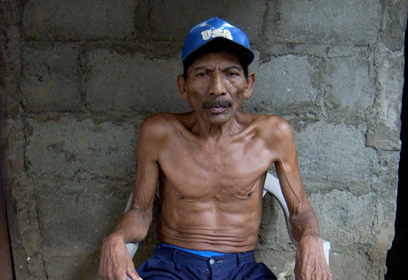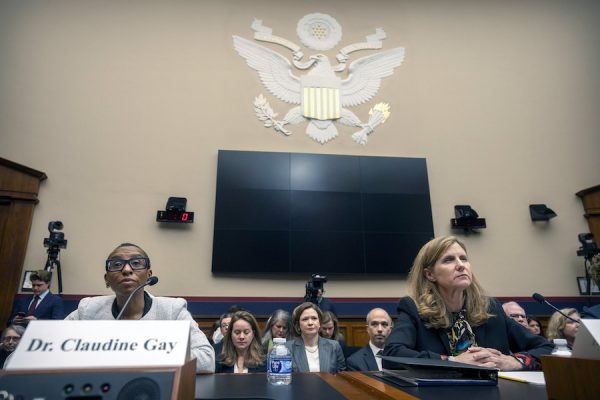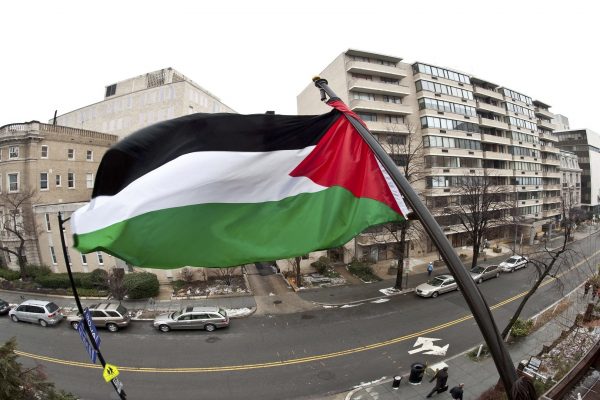Martin Enrique Perez was rendered sterile by exposure to the pesticide DBCP while working in Nicaragua’s banana fields. Photograph: Manuel Angel Esquivel Urbina.
It was easy to find Antonio Hernández Ordeñana’s office in Chinandega, Nicaragua. Although the city is Nicaragua’s fourth largest, Hernández is well known, and the locals had no problem pointing the way.
When I visited in 2006, the building looked newly painted in a bright green, with large letters on the front declaring, “Legal Offices for Banana Workers.” Twenty or thirty men waited in a lobby just as hot as the day outside. The men, most of them in their sixties, no longer labored in the fields—the banana industry had faded decades before. They had come to Hernández for reasons documented in scores of newspaper clippings tacked to the waiting room wall. Headlines announced the meetings, protests, and legal struggles of los afectados—former banana workers made sterile by exposure to the pesticide dibromochloropropane, also known as DBCP, Fumazone, or Nemagon.
Beyond the lobby, offices and storerooms were arranged around a leafy central courtyard. Hernández took me to a room crammed with files, where he explained the strategy he and Los Angeles–based attorney Juan José Domínguez were pursuing. Like a handful of other Nicaraguan and U.S. firms, theirs were filing cases against fruit and chemical companies in both countries in hopes of securing compensation for banana workers exposed in the 1970s and early ’80s, when DBCP was widely used to control soil-dwelling nematodes that fed on the roots of banana plants. Along with volumes of paper, the offices held objects that spoke to the pesticide’s history and legacy. One, a metal barrel, dull and rusty with age, bore Dow Chemical’s diamond-shaped logo and its Fumazone brand name. The label included no warning of serious health effects, and, in any case, was in English, which wasn’t much use to the rural laborers who dispensed its contents. Across the courtyard was a modest laboratory, used by a visiting technician to measure sperm counts. Warning me not to be shocked, Hernández brought me to the threshold of a small room adjacent to the lab. I could see through the doorway that the walls were hung with soft-core porn. This is where would-be plaintiffs were sent to provide semen samples.
One of Hernández’s most controversial cases—originally known as Tellez—has travelled a roller coaster route between his offices and the doorstep of the California Supreme Court in San Francisco, more than 3,000 miles northwest of Chinandega. What seemed the height of victory for plaintiffs—a 2007 Los Angeles jury verdict in favor of six Nicaraguans—was transformed into defeat when that decision was reversed by Judge Victoria Chaney in 2010. The case—now in the hands of California appellate lawyer Steve Condie—ground to a halt this spring when the California Supreme Court refused a petition to review Chaney’s reversal.
Tellez is only the latest chapter in decades of tumultuous transnational DBCP litigation. The first Central American DBCP plaintiffs filed in Florida in 1983. Then, tort lawyers representing banana workers had every reason to be hopeful: after U.S. chemical production workers had conclusively linked their sterility to DBCP in 1977, they won up to $2 million each in their own lawsuits. Plaintiffs also had a nice assortment of “smoking gun” documents, including toxicological evidence of testicular effects dating to 1956 and an agreement between Dow and Dole to continue DBCP sales to banana plantations after DBCP was undisputedly understood to cause human sterility. Perhaps most damning, one 1978 Dole memo gave instructions to ignore safety precautions because they were “not operationally feasible.”
It wasn’t until 2007, when Tellez reached Los Angeles superior court, that a jury would get a chance to see these smoking guns. For decades corporations including Dole, Dow, Shell, Chiquita, and Occidental Chemical focused on preventing cases from being heard in the United States. Although plaintiffs filed in courts with jurisdiction, defendants turned to a dusty legal doctrine called forum non conveniens (FNC) to convince judges to dismiss on the grounds that the cases were more “conveniently” heard in workers’ home nations. Each FNC dismissal was a de facto victory for defendants, as workers’ home courts usually had high barriers to filing and offered little hope of significant restitution. Dragging out the conflict also stacked the deck in favor of the defendants. In contrast to sterilized workers, corporations—though considered people for some legal purposes—lack bodies vulnerable to time and disease. The fact that plaintiffs were sterile ensured there would be few children to bring suits on the part of their fathers. With enough procedural delay, the suits would likely die with the plaintiffs.
By the early 1990s, banana workers had grown disgusted with accumulating FNC dismissals and with two negotiated settlements that left them with little compensation—a few thousand dollars here, a few hundred there. So afectados organized and pressed for a law that would ease the filing of DBCP cases in Nicaragua. Law 364 was enacted in 2001, and a year later judges began returning verdicts of hundreds of millions of dollars. From the defendants’ viewpoint, Nicaragua no longer looked so convenient.
But bringing suit in Nicaragua had its inconveniences for plaintiffs, too. With few assets at stake there, defendants refused to pay awards, even bringing the nation into costly trade agreement arbitration when a judge dared try to enforce one verdict.
Tellez was a bellwether case. If the plaintiffs were successful, their awards would set the standard for future verdicts and settlements. As twelve afectados went to trial, thousands more waited in the wings. After months of testimony, the Los Angeles jury returned with a modest victory for plaintiffs. Six were awarded a combined $5.7 million. Hundreds of Chinandegans celebrated in the street in front of Hernández’s office. Amid the music, dancing, and fireworks, the lawyer told the Nicaraguan press, “We were fighting giants . . . but our clients won.”
The victory, however, wouldn’t last for long. First, Judge Chaney granted defendants’ motion to reverse a punitive award—$2.3 million of the total—on the grounds that a California court had little interest in punishing a U.S. corporation for actions outside U.S. borders. Then, chagrined by even the remaining judgment against their company, Dole leadership moved aggressively to vacate two similar cases—Mejia and Rivera—queued for trial in Chaney’s court. Dole and its lawyers developed what they called the “kill step”: they would discredit their legal adversaries. At the strategy’s core were a number of witnesses who alleged that workers and plaintiff’s lawyers—including Hernández and Domínguez, as well as Nicaraguan judges—had orchestrated a thoroughgoing fraud. The story had a built-in defense mechanism: defendants told Chaney that witnesses had suffered intimidation so intense that they feared violence and would not testify if their names were made public. Judge Chaney, suspicious of what she called an “odd social ecosystem” “down there” in Nicaragua, fully credited the eleventh-hour testimony. She issued a series of rulings keeping the fraud witnesses’ identities secret—even from Hernández and Domínguez—and drastically limited the ability of other lawyers on the plaintiffs’ team to cross-examine witnesses or investigate their allegations.
Ironically, the judge’s secrecy order inflamed public discussion of the case in Nicaragua. A handful of Nicaraguans told reporters there that they were the secret witnesses. A union leader implicated by the secret testimony filed a legal action in Nicaragua, resulting in sworn testimony from at least seven people to the effect that Dole personnel had offered them cash to serve as secret witnesses in the California litigation.
Parts of the defendants’ story unraveled in the United States as well. Condie, “appalled” at what he saw as “an egregious misuse of our legal system,” took over the case, renamed Laguna, in 2009. He soon uncovered unimpeachable evidence—passport stamps—disproving witnesses’ allegations that plaintiffs’ lawyers had attended a supposed meeting of conspirators. Other testimony revealed that two of the key fraud witnesses were enjoying long-term stays in a Costa Rican luxury hotel, compliments of Dole.
Despite the holes in Dole’s fraud story, the accusations of Nicaraguan corruption stuck, while reports of Dole’s dishonesty failed to gain traction. Chaney dismissed Mejia and Rivera in 2009, a year before overturning Tellez. Condie’s arguments hinged on violations of due process, defendants’ use of inadmissible evidence, and bias on the part of the judge who “question[ed] the authenticity and reliability of any documentary evidence presented by plaintiffs that comes out of Nicaragua.” In March, however, these arguments failed to sway the California Court of Appeal. Meanwhile USA Today and Bloomberg Businessweek have trumpeted the corruption allegation; USA Today’s article was penned by Theodore Boutrous, an attorney for Gibson, Dunn & Crutcher, the law firm Dole hired to litigate on its behalf. In 2010 the firm established a “transnational litigation practice group,” which suggests that we have not seen the last of the kill step in suits involving international plaintiffs. Indeed, Gibson, Dunn & Crutcher has engineered a similar campaign against Ecuadoreans suing Chevron-Texaco for pollution related to oil extraction.
The California Supreme Court’s refusal to review came with no published comments or reasoning, leaving the case’s contradictions intact and keeping the secret testimony insulated from thorough investigation or cross examination. The plaintiffs’ journey could continue: Condie is contemplating an appeal to the U.S. Supreme Court. In Chinandega, though, the brief moment of celebration that came in 2007 is long past, and hopes for justice have waned after so many years of defeat.








